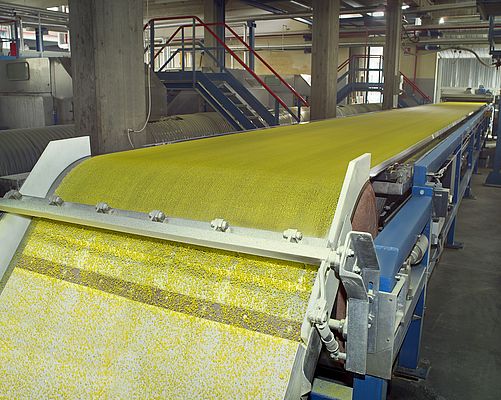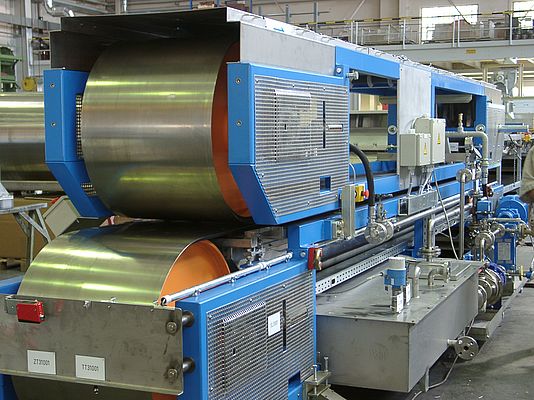Rare are those industries that don’t make use granulated products at some stage, be they food additives or emulsifiers, speciality resins or waxes, or other melts that have been solidified for ease of handling or dosing.
Seventy five years ago this year, Sandvik launched the world’s first steel belt cooler, designed for the solidification of resin/wax products and sulphur mixtures.
Since then, many thousands of steel belts have been produced for cooling and solidification applications involving a genuine A to Z of products: from antioxidants, bitumen and calcium chloride all the way to zinc stearate. They deliver high capacity sulphur granulation at oil refineries around the world; they are used for foodstuffs as diverse as chocolate and chewing gum base; and they provide reliable service in aggressive environments such as fertilizer plants.
So what is it about the stainless steel belt that makes it so well suited to these and dozens of other solidification applications? In order to understand this, we need to look at the cooling/solidification process that is at the heart of all these systems.
The basic principle of every Sandvik steel belt-based cooling system is the same, irrespective of the feed method or additional up- or downstream equipment supplied. A molten product is delivered onto a continuously running steel belt. As the belt travels along the process line, cold water is sprayed against its underside and the heat of the melt product is transferred, via the steel belt, to the water. The product remains untouched and the cooling water is simply collected in tanks, recooled and recirculated. The rapid but controlled transfer of heat results in solidification of the product, which is then discharged at the end of the line.
The use of stainless steel as a belt material, with its inherently hard, flat and smooth surface, also ensures clean discharge of the end product and easy cleaning. Other qualities include strength and flexibility, good resistance to extremes of temperature and the ability to handle abrasive or corrosive materials. Taking an indirect approach to solidification also has the environmental benefit of eliminating any possibility of cross contamination between process product and cooling media.
Single belt cooling in flake form
This core technology provides the foundation on which a whole range of melt granulation systems are built. The most widely used is the single belt cooler, which can be tailored to particular process requirements. The technology that determines the form of the end product is the feeding device and several options are available to handle products with viscosities from 1 to 100,000 mPas.
One example is the flaking process, an economical solution for high capacity production of bulk materials. The melt is applied to the steel belt (retaining strips of Neoprene or rubber prevent the product from spilling over the edges of the steel belt) and solidifies in an even layer. At the discharge end, a crusher breaks the solid product layer into small irregular flakes.
Double belt solutions
An alternative method of granulation in the form of flakes is the double belt system, which offers increased efficiency through the addition of an upper belt. This, like the lower belt, is cooled by means of chilled water but in this instance it’s removed for re-chilling by suction pump rather than gravity.
The double belt system is ideally suited to high capacity operations or installations where floor space is limited. It can be used to solidify difficult products, including certain types of resin that are prone to curling away from a single steel belt. And it can also handle thicker products, achieving a uniform temperature through the whole section.
Rotoform pastillation
While providing a simple and economical solution, flakes are not necessarily an ideal form for bulk handling or high density storage. For applications where these factors are important, Sandvik’s Rotoform process has proved an effective solution for almost 30 years.
In this system, the liquid product is fed to a heated cylindrical stator around which turns a perforated shell, synchronised to the speed of the belt. This set up delivers the product onto the belt in the form of droplets. As with the flaking system, the heat released during solidification is transferred by the stainless steel belt to the cooling water sprayed underneath; the solidified pastilles are then discharged at the end of the process line and transported away for weighing/bagging or bulk storage.
Solidification in this form offers a number of important benefits both to the processor and to those who subsequently reuse the product. Its uniformity of shape and size (determined by the diameter of the holes in the rotating shell and hence adjustable by simply switching shells) makes it free-flowing for easy handling, while its high bulk density is a major advantage in terms of storage and transportation.
Environmentally-friendly processing
One area in which ease of handling is an extremely important factor is the sulphur now extracted in huge volumes as part of the modern oil and gas refining process. In its liquid form, sulphur is expensive both to store and to transport so it has to be solidified and the Rotoform process – including a recently developed high capacity model – has become the system of choice at many refineries.
Alongside the quality of end product, determined to be ‘Premium’ by the industry standard SUDIC (Sulphur Development Institute of Canada) test, another major reason for the success of the Rotoform process in this particular field are its environmental advantages.
As well as the complete lack of contact between product and water already covered, the short residence time on the cooling belt means that very little vapour or gas can get into the atmosphere and emissions are well within the limits of international laws. And the low friability of this product form means it’s virtually dust free, enabling safe outdoor storage and transportation.
Specialist systems for different granulation applications
While the basic principle of the Rotoform process has remained unchanged since it was introduced in the early 1980s, developments driven by the needs of different industries and process requirements have seen the creation of an entire family of systems.
This includes models capable of handling melts that need to be fed at temperatures of up to 320ºC; systems for handling abrasive, sedimenting and corrosive products and a ‘high hygiene’ version with the easy-to-clean properties required by the food industry.
The same basic technology can also be used to overcome the challenge of so-called subcooling melts, products such as certain agrochemicals, stabilizers and plastic additives which lack the nuclei necessary for crystallisation and solidification, remaining liquid even when cooled down to below their melting point.
Such is the versatility of steel belt-based granulation, particularly pastillation, that new applications continue to be developed all the time, a recent example being the pastillation of fertilizer urea, a breakthrough that is proving to be anything from 30% to 60% less costly in initial investment terms than existing systems on the market.
For 75 years now, the steel belt has formed the basis on which thousands of cooling and solidification systems have been built, and it is a technology that shows no signs of ageing.
Written by: Ulrich Nanz, Sales Manager of Sandvik Process Systems
Solidification and granulation of melts
with steel belt coolers
- by Sandvik Process Systems GmbH
- August 16, 2010
- 4763 views


















